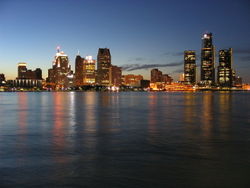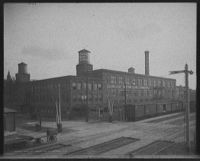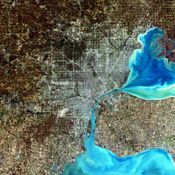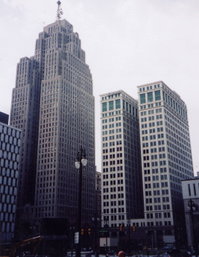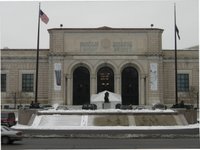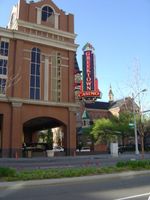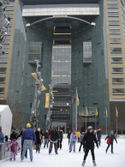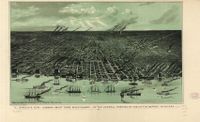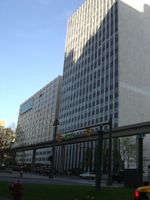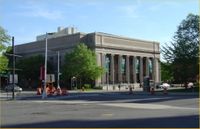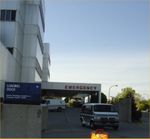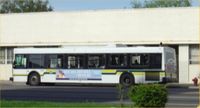Detroit, Michigan
2007 Schools Wikipedia Selection. Related subjects: North American Geography
| Detroit, Michigan | |||||
|
|||||
| Nickname: "Motor City, Motown" | |||||
| Motto: Speramus Meliora; Resurget Cineribus" (Latin for, "We Hope For Better Things; It Shall Rise From the Ashes") |
|||||
| Location in Wayne County, Michigan | |||||
| Coordinates: | |||||
|---|---|---|---|---|---|
| Country | United States | ||||
| State | Michigan | ||||
| County | Wayne County | ||||
| Mayor | Kwame Kilpatrick | ||||
| Area | |||||
| - City | 370.2 km² (143.0 sq mi) | ||||
| - Land | 359.4 km² (138.8 sq mi) | ||||
| - Water | 10.8 km² (4.2 sq mi) | ||||
| - Metro | 9,453 km² (3,650 sq mi) | ||||
| Elevation | 190 m (623 ft) | ||||
| Population | |||||
| - City (2005) | 886,675 | ||||
| - Density | 2,647/km² (6,856/sq mi) | ||||
| - Metro | 4,488,335 | ||||
| Time zone | EST ( UTC-5) | ||||
| - Summer ( DST) | EDT ( UTC-4) | ||||
| Website: http://www.detroitmi.gov/ | |||||
Detroit ( IPA: [dɪˈtʰɹɔɪt]) (French: Détroit, pronounced [detʁwa] ) is the largest city in the U.S. state of Michigan and is the seat of Wayne County.
Founded in 1701 by French fur traders, it is a major port city, located north of Windsor, Ontario, on the Detroit River in the Midwest region of the United States. It is known as the world's traditional automotive centre and an important source of popular-music legacies, celebrated by the city's two familiar nicknames, Motor City and Motown. The city's name comes from the Detroit River (in French Rivière du Détroit), meaning "River of the Strait." The name alludes to the connection the river forms between Lake St. Clair and Lake Erie.
In 2005, Detroit ranked as the United States's 11th most populous city, with 886,675 residents; this number is less than half the peak population in 1950, and Detroit is among the leaders in the nation in terms of declining urban population over the past fifty years. It is the focal city of the nation's tenth-largest metropolitan area.
Detroit's crime rate has brought it notoriety, while the city continues to struggle with the burdens of racial disharmony between itself and its suburban neighbors. The city has experienced budget shortfalls, leading to cuts in city services. Nevertheless, Detroit is currently experiencing a downtown revival with the construction of the Compuware headquarters, a recently renovated Renaissance Centre, three gambling casinos, new stadiums and the Detroit Riverwalk. The city serves as an entertainment hub for the metropolitan region.
Residents are generally known as "Detroiters." The name Detroit is also sometimes used as shorthand for the entire Metro Detroit area, a sprawling region with a population of 4,488,335 for the Metropolitan Statistical Area and a population of 5,456,428 for the nine county Combined Statistical Area as of the 2005 Census Bureau estimates. If the adjacent Canadian city of Windsor, Ontario and its suburbs are counted, the area has a total population of about 6 million (see: Windsor-Detroit).
The city was called the Paris of the West in the late 19th century due to its elegant architecture and public squares; in the mid-20th century it was called Rock City due to its association with the development of rock music. Today, local colloquialisms for the city include The D, The 313 (its area code) and D City.
History
Early beginnings: Founded by the French
Traveling up the Detroit River on the ship Le Griffon (previously captained by La Salle), Father Louis Hennepin noted the north bank of the river as an ideal location for a settlement. There, in 1701, French officer Antoine de la Mothe Cadillac founded a fort and settlement called Fort Pontchartrain du Détroit, naming it after the comte de Pontchartrain, minister of marine under Louis XIV. The settlement prospered as a fur-trading centre, and the fort offered protection for French ships plying the Great Lakes.
In 1760, during the French and Indian War, British troops gained control of the area and shortened the name of the settlement to Detroit. Local Native American tribes, many of whom had developed friendly relations with French colonists, became alarmed at this development. In 1763, several tribes led by Chief Pontiac, an Ottawa leader, launched what became known as Pontiac's Rebellion, which included a siege of Fort Detroit; they were ultimately defeated by the British. In 1796, Detroit passed to the United States under the Jay Treaty. In 1805, fire destroyed most of the settlement; a river warehouse and brick chimneys of the wooden homes were the sole structures to survive. Detroit's city flag reflects this French heritage. (See Flag of Detroit, Michigan.)
War of 1812: British rule Detroit
From 1805 to 1847, Detroit was the capital of Michigan. As the city expanded, the street layout followed a plan developed by Augustus B. Woodward, Chief Justice of the Michigan territory. Detroit fell to British troops during the War of 1812 in the Siege of Detroit, was recaptured by the United States in 1813 and incorporated as a city in 1815. Prior to the American Civil War, the city's access to the Canadian border made it a key stop along the underground railroad.
American Civil War
Many Detroiters volunteered to fight during the American Civil War. Following the death of President Abraham Lincoln, George Armstrong Custer delivered a eulogy to the thousands gathered near Campus Martius Park. Custer had led the Michigan Brigade during the American Civil War and had called them the "Wolverines."
The Gilded Age and Industrialization
Detroit's many Gilded Age mansions and buildings arose during the late 1800s. The city was referred to as the "Paris of the West" for its fine architecture. Strategically located along the Great Lakes waterway, Detroit emerged as a transportation hub. The city had grown steadily from the 1830s with the rise of shipping, shipbuilding, and manufacturing industries. In 1896, a thriving carriage trade prompted Henry Ford to build his first automobile in a rented workshop on Mack Avenue, and in 1904, the Model T was produced. Ford's manufacturing—and those of automotive pioneers William C. Durant, the Dodge brothers, and Walter Chrysler reinforced Detroit's status as the world's automotive capital. The industry spurred the city's spectacular growth during the first half of the 20th century as it drew many new residents, particularly workers from the Southern United States. Strained racial relations were evident in the trial of Dr. Ossian Sweet, a black Detroit physician acquitted of murder after he shot into a large mob when he moved from the all-black part of the city to an all-white area. With the introduction of prohibition, the river was a major conduit for Canadian spirits, organized in large part by the notorious Purple Gang.
World War I and World War II
With the factories came high-profile labor strife, climaxing in the 1930s as the United Auto Workers initiated bitter disputes with Detroit's auto manufacturers. The labor activism established during those years brought notoriety to hometown union leaders such as Jimmy Hoffa and Walter Reuther. The 1940s saw the construction of the world's first urban depressed freeway, the Davison and the industrial growth during World War II that led to Detroit's nickname as the Arsenal of Democracy.
1960s
Detroit endured a painful decline during the 1960s and 1970s and was often held up as a symbol of urban blight. The 12th Street Riot in 1967 and court-ordered busing accelerated white flight from the city. The percentage of black residents increased rapidly thereafter, as not only did the whites flee the city, but the migration of blacks from the south continued. The city's tax base began a steep decline as retailers and small business owners departed the city in the wake of the riots. Within a decade large numbers of buildings and homes were abandoned on the southeast side of the city, with many remaining for years in a state of decay. In 1973, the city elected its first black mayor, Coleman Young. Young's style during his record five terms in office was not well received by many whites.
1970s
The gasoline crises of 1973 and 1979 shook the United States auto industry as Japanese and other foreign car makers of small cars made inroads into the traditional dominance of the Big Three automakers. High-paying manufacturing jobs became scarce and the city soon faced the acute heroin and crack cocaine epidemics which afflicted many U.S. cities at that time. Drug-related violence and property crimes rose steeply, while many abandoned homes were razed as they had become havens for drug dealers. Devil's Night, a Detroit-area tradition which occurs the night before Halloween, evolved from a night of pranks to a night of large-scale arson across the city. Sizeable tracts have reverted to nature, to become a form of urban prairie with wild animals spotted migrating into the city. "Renaissance" has been a perennial buzzword among city leaders since the 12th Street riot, reinforced by the construction of the Renaissance Centre in the late 1970s.
1980 - present
In 1980, Detroit hosted the Republican National Convention which nominated Ronald Reagan to a successful bid for President of the United States. The city received limited positive notoriety for much of the rest of the decade, though, as its economy faltered badly and its crime rate gained national headlines; the city's reputation as a dangerous place was reinforced by rioting following the Detroit Tigers' 1984 World Series title and the Detroit Pistons' second NBA championship, in 1990.
In the 1990s, the city began to enjoy a revival, much of it centered downtown. In 1994, Comerica Tower with its postmodern architecture and neo-gothic spires arose on the city skyline. In 1996 onwards, three casinos opened: MGM Grand Detroit, Motor City Casino, and Greektown Casino. In 2000, Comerica Park replaced historic Tiger Stadium as the home of the Detroit Tigers, and in 2002, Ford Field brought the NFL's Detroit Lions back into Detroit, from Pontiac. The 2004 opening of the Compuware Centre gave downtown Detroit its first significant new office building in a decade. The city hosted the 2005 MLB All-Star Game and Super Bowl XL in 2006, both of which prompted many improvements to the downtown area. Additionally, the first portions of the Detroit River Walk were laid down. In the summer of 2006, announcements came for the redevelopment of the abandoned Fort Shelby and Book-Cadillac Hotels. In the fall, The Detroit Tigers won the American League Pennant by shutting out the New York Yankees (who were only shut out five times in their regular season) in two games in a row. Detroit then hosted World Series games for the first time in 22 years (where the St. Louis Cardinals defeated the Tigers in five games).
Geography
Topography
According to the United States Census Bureau, the city has a total area of 143.0 square miles (370.2 km²); of this, 138.8 square miles (359.4 km²) is land and 4.2 square miles (11 km²) is water. The highest elevation in Detroit is in the University District neighbourhood in northwestern Detroit, just west of Palmer Park sitting at a height of 670 feet (204 m). Detroit's lowest elevation is along its riverfront, of course, sitting at a height of 579 feet (176 m). Detroit completely encircles the cities of Hamtramck and Highland Park. On its northeast border are the wealthy communities of Grosse Pointe. Oakland and Macomb counties lie to the north. Alter Road divides Detroit and Grosse Pointe Park. It divides one of the poorest and most crime-ridden communities in the United States from one of the most affluent, with multi-million dollar mansions on Lake Shore Drive in the Grosse Pointes.
The city is crossed by three road systems: the original French template, radial roads from a Washington, D.C.-inspired system, and true north–south roads from the Northwest Ordinance township system. It sits atop a large salt mine and is north of Windsor, Ontario. Detroit is the only major city along the U.S.-Canadian border in which one travels south in order to cross into Canada. Detroit has four border crossings: the Ambassador Bridge and the Detroit-Windsor Tunnel provides motor vehicle thoroughfare and the Michigan Central Railway Tunnel railroad access to and from Canada. The fourth border crossing is the Detroit-Windsor Truck Ferry, located near the Windsor Salt Mine and Zug Island.
Climate
Detroit and the rest of southeastern Michigan have a typically Midwestern temperate seasonal climate, which is influenced by the Great Lakes. Winters are cold with moderate snowfall; summers are warm. The earliest officially measurable snowfall in Detroit occurred on October 12, 2006. The average high and low temperatures in July are 85° F (29° C) and 65°F (18°C) respectively, and in January 31°F (1°C) and 20°F(-6°C). Summer temperatures can typically exceed 90°F (32°C). Winters are often cold but temperatures very rarely drop below 0°F (–17°C). Average monthly precipitation ranges from about two to five inches (50 to 130 mm), being heaviest in the summer months. Snowfall, which typically occurs from November to early April, ranges from 1 to 10 inches (3 to 25 cm) a month. The highest recorded temperature was 103.0°F (39.0°C) on June 25, 1988, while the lowest recorded temperature was –17.0°F (–27.0°C) on January 19, 1994.
| Weather averages for Detroit, Michigan | |||||||||||||
| Month | Jan | Feb | Mar | Apr | May | Jun | Jul | Aug | Sep | Oct | Nov | Dec | Year |
|---|---|---|---|---|---|---|---|---|---|---|---|---|---|
| Avg high °F | 31 | 33 | 44 | 58 | 70 | 79 | 83 | 81 | 74 | 62 | 48 | 35 | 58 |
| Avg low °F | 16 | 18 | 27 | 37 | 48 | 57 | 62 | 60 | 53 | 41 | 32 | 22 | 39 |
| Avg high °C | -1 | 1 | 6 | 14 | 21 | 26 | 28 | 27 | 23 | 16 | 8 | 1 | 14 |
| Avg low °C | -8 | -7 | -2 | 2 | 8 | 13 | 16 | 15 | 11 | 5 | 0 | -5 | 3 |
| Precipitation (in) | 1.9 | 1.7 | 2.4 | 3.0 | 2.9 | 3.6 | 3.1 | 3.4 | 2.8 | 2.2 | 2.7 | 2.5 | 32.3 |
| Precipitation (cm) | 4 | 4 | 6 | 7 | 7 | 9 | 7 | 8 | 7 | 5 | 6 | 6 | 82 |
| Source: Weatherbase Nov 2006 | |||||||||||||
Cityscape
The panoramic Detroit skyline shows a variety of architectural styles. The city has one of America's largest surviving collections of 1920's and 1930's skyscrapers and historic structures. The Art Deco style from this period is exemplified by the Guardian Building downtown as well as the Fisher Building and Cadillac Place in the New Centre adjacent to Wayne State University. Among the city's prominent structures are the nation's first Fox Theatre, the Detroit Opera House, and the Detroit Institute of Arts. These and other historic buildings mingle with the post modern neo-gothic Comerica Tower and the gleaming towers of the Renaissance Centre downtown near the Detroit River.
While the downtown and New Centre areas contain high-rise buildings, the majority of the surrounding city consists of low-rise structures and single-family homes. In 2005, Detroit's architecture was heralded as some of America's finest; many of the city's architecturally significant buildings are listed by the National Trust for Historic Preservation as among America's most endangered landmarks.
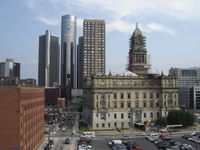
Detroit has an active community of professionals dedicated to urban design, historic preservation, architecture, and investment in the city. A number of downtown redevelopment projects — of which Campus Martius Park is one of the most notable — have revitalized parts of the city. In 2006, a state-of-the-art cruise ship dock was added to Hart Plaza. Grand Circus Park stands near the city's theatre district and Comerica Park, home of the Detroit Tigers. Since the 1990s, there have been plans to redevelop the riverfront area from the Ambassador Bridge to Belle Isle (the largest island park in a U.S. city) with a combination of parks, residential buildings, and commercial areas. Other major parks include Palmer (north of Highland Park), River Rouge (in the southwest side), and Chene Park (on the Detroit River east of downtown).
Detroit is constructing a riverfront promenade park similar to the one directly across the river in Windsor, Ontario. Windsor replaced acres of train tracks and some abandoned buildings with what is now 3 miles (5 km) of uninterrupted parkland. The Detroit Riverfront Conservancy is spearheading most of this development. A project includes the new Tri-Centennial State Park and Harbour, Michigan's first urban state park. Civic planners envision that the newly reclaimed riverfront with pedestrian parks will spur more residential development.
Culture
Contemporary life
Metro Detroit suburbs are among the most affluent in the nation. Lifestyles for rising professionals in Detroit reflect those of other major cities. This dynamic is luring many younger professionals to the downtown. Luxury high rises such as the three Riverfront Towers have views of Hart Plaza and Canada. Examples abound with developments in the city's New Centre area. The Westin Book-Cadillac Hotel will include a number of luxury condos. The east river development plans include even more luxury condominium developments. A desire to be closer to the urban scene has attracted young professionals to take up residence among the mansions of Grosse Pointe just outside the city. Detroit's proximity to Windsor, Ontario provides for spectacular views and a dynamic nightlife, along with Ontario's 19-and-older drinking age.
Performing Arts
Music has been the dominant feature of Detroit's nightlife since the late 1940s. The metropolitan area boasts two of the top live music venues in the United States: DTE Energy Music Theatre and The Palace of Auburn Hills The city's theatre district is the nation's second largest in terms of seats. Major theaters include the Fox Theatre, Masonic Temple Theatre, the Detroit Opera House, and the Fisher Theatre. Detroit's Orchestra Hall is the home of the Detroit Symphony Orchestra.
In the 1940's, Detroit had a bustling blues scene with the long-term residency of John Lee Hooker. During the 1950s, the city became a centre for jazz, in which stars of the era often came to the Black Bottom neighbourhood to perform. One highlight of Detroit's musical history was Motown Records' success during the 1960s and early 1970s. The label was founded in Detroit by Berry Gordy, Jr. and spawned acts such as The Temptations, Four Tops, Smokey Robinson, Diana Ross & The Supremes, Marvin Gaye and Aretha Franklin. Gordy moved Motwon to Los Angles in 1970 to pursue film producing opportunities, but the company has since moved back to Detroit.
Metro Detroit also spawned a high-energy rock scene in the late 1960s and 1970s centered around the Grande Ballroom with artists like Alice Cooper, Ted Nugent, Mitch Ryder, Rare Earth, Brownsville Station, Glenn Frey and Bob Seger. The group KISS captured the essence of Detroit's love for rock music in the song "Detroit Rock City." This rock scene is considered one of the precursors of the punk rock movement, with the MC5 and Iggy Pop's various projects (including The Stooges) being some of the foremost proto-punk bands.
In addition, Detroit's garage rock scene of the 1990s rose to national attention with the success of bands such as The White Stripes, Von Bondies, the Dirtbombs, and Electric Six. Its hip hop scene also rose to prominence in the late nineties with the emergence of nationally renowned acts such as Eminem, Slum Village, D12, J Dilla, Obie Trice, Blade Icewood, Big Herk, and Royce Da 5'9.
Several annual music events are held around the city, including the Ford Detroit International Jazz Festival, the Motor City Music Conference (MC2), the Concert of Colors, and the hip-hop Summer Jamz music festival.
Fashion
The Renaissance Centre's Winter Garden is the site of the annual "Fash Bash", a major fashion event traditionally held in August. Coordinated by the Detroit Institute of Arts, the event features celebrities and models showcasing the latest fashion trends.
In 1991, a cultural phenomenon began among hair salons which evolved into the Detroit Hair Wars. A showcase of fantastical hair piece creations, often using human hair as the main content, has since become a national trend among African-American hair-styling tours.
Tourism
Many of Metro Detroit's museums are located in the Cultural Centre near Wayne State University. These museums include Detroit Institute of Arts, the Detroit Historical Museum, Charles H. Wright Museum of African American History, Detroit Science Centre, and the main branch of the Detroit Public Library. Other cultural highlights include Motown Historical Museum, Tuskegee Airmen Museum, Fort Wayne, Dossin Great Lakes Museum, the Museum of Contemporary Art Detroit (MOCAD), and the Belle Isle Conservatory. Important history of Detroit and the surrounding area is exhihibited at the The Henry Ford, the nation's largest indoor-outdoor museum complex.
The Detroit Historical Society at the Detroit Historical Museum provides information about tours of Detroit area churches, skyscrapers, and mansions. Of the mansions built by the auto barons in the area, only the Fisher Mansion is in Detroit. The Eastern Market farmer's distribution centre is the largest open-air flowerbed market in the United States and has more than 150 foods and specialty businesses.
Hart Plaza, between the Renaissance Centre and Cobo Hall on the riverfront, is the site of many events including the Windsor-Detroit International Freedom Festival in late June with one of the nation's largest displays of fireworks and the Detroit Electronic Music Festival. Within downtown, Campus Martius Park hosts events such as the Motown Winter Blast. As the world's traditional automotive centre, Detroit hosts the North American International Auto Show. The America's Thanksgiving Parade — previously referred to as the Hudson's Thanksgiving Day Parade — is one of the nation's largest and has been held continuously since 1924.
Other sites of interest are the Detroit Zoo, the Anna Scripps Whitcomb Conservatory, and the Belle Isle Aquarium. The aquarium on Belle Isle is currently closed. The J.W. Westcott II, which delivers mail to freighters on the Detroit River, is the world's only floating post office.
The most important civic sculpture in Detroit is Marshall Fredericks' " Spirit of Detroit" at the Coleman Young Municipal Centre. The image is often used as a symbol of Detroit and the statue itself is occasionally dressed in sports jerseys to celebrate when a Detroit team is doing well. A memorial to Joe Louis at the intersection of Jefferson and Woodward Avenues was dedicated on October 16, 1986. The sculpture, commissioned by Sports Illustrated and executed by Robert Graham, is a 24 foot (7.3 m) long arm with a fisted hand suspended by a pyramidal framework.
Artist Tyree Guyton created the controversial street art exhibit known as the Heidelberg Project in the mid 1980s. The exhibit used junk and abandoned cars, clothing, shoes, vacuum cleaners, and other garbage Guyton found in the neighbourhood near and on Heidelberg Street on the near East Side of Detroit. Guyton painted polka dots and other symbols on several houses on Heidelberg Street. The city sued Guyton twice for creating a public nuisance, removed large parts of his art project, and tore down two vacant homes he had painted with various symbols. Nevertheless, much of the Heidelberg Project remains today.
Sports
Detroit is home to professional teams representing the four major sports in North America. All but two play within the city of Detroit itself (basketball's Detroit Pistons and Detroit Shock play in suburban Auburn Hills). There are three active major sports venues within the city: Comerica Park (home of the baseball team Detroit Tigers), Ford Field (home of the football team Detroit Lions), and Joe Louis Arena (home of the ice hockey team Detroit Red Wings). Detroit is known for its avid hockey fans, earning the city the moniker of "Hockeytown."
In college sports, the University of Detroit Mercy has a NCAA Division I program, and Wayne State University has both NCAA Division I and II programs. The NCAA football Motor City Bowl is held at Ford Field each December.
Since 1904, the city has been home to the American Power Boat Association Gold Cup unlimited hydroplane boat race, held annually on the Detroit River near Belle Isle. Detroit was the former home of a round of the Formula One World Championship, which held the race on the streets of downtown Detroit from 1982 until 1988, after which the sanction moved from Formula One to Indycars until its final run in 2001. In 2007, open-wheel racing will return to Belle Isle with both Indy Racing League and American Le Mans Series Racing.
City of Champions
Detroit was given the name "City of Champions" in the 1930s for a series of successes both in individual and in team sport. Gar Wood (a native Detroiter) won the Harmsworth Trophy for unlimited powerboat racing on the Detroit River in 1931. In the next year, 1932, Eddie "The Midnight Express" Tolan, a black student from Detroit's Cass Technical High School, won the 100- and 200-meter races and two gold medals at the 1932 Olympics. Joe Louis won the heavyweight championship of the world in 1937. Also, surprisingly in 1935, the Detroit Lions won the National Football League championship. The Detroit Tigers won the American League pennant in 1934 and again in 1935. And the Tigers won the World Series in 1935, defeating the Chicago Cubs. The Detroit Red Wings won the National Hockey League's Stanley Cup in 1936 and 1937
The Red Wings would go on to become Detroit's most successful sports team, winning the Stanley Cup again in 1943, 1950, 1952, 1954, 1955, 1997, 1998, and 2002.
The Detroit Pistons have also had eras of glory, with championships in 1989, 1990, and 2004.
Comerica Park hosted the MLB All-Star Game on July 12, 2005 and Ford Field hosted Super Bowl XL on February 5, 2006. On December 13, 2003, the largest crowd in basketball history (78,129) packed Ford Field to watch the University of Kentucky defeat Michigan State University, 79-74.
The Detroit Tigers experienced a renaissance of their own in 2006, becoming an elite team again after decades of losing. After defeating the New York Yankees in the ALDS, and the Oakland Athletics in the ALCS, Comerica Park hosted games 1 and 2 of the 2006 World Series, as the Tigers lost to the St. Louis Cardinals.
Economy
Detroit and the surrounding region constitute a manufacturing powerhouse, most notably as home to the Big Three automobile companies. The city is an important centre for global trade with large international law firms having their offices in both Detroit and Windsor. There are hundreds of offices and plants in the automotive support business: parts, electronics, and design suppliers. The domestic auto industry accounts directly and indirectly for one of every ten jobs in the U.S. The area is an important source of engineering job opportunities.
With its dependence on the auto industry, Detroit is more acutely vulnerable to economic cycles than most large cities. A rise in automated manufacturing using robot technology, inexpensive labor in other parts of the world, and increased competition from foreign rivals have led to a steady decline in certain types of manufacturing jobs in the region. Other complications for the city include higher taxes than the nearby suburbs, with many unable to afford the cost of citizenship entailed by levies on property and income and a lack of city services. In February 2006, metropolitan Detroit's unemployment rate was 8.6%, topped only by communities devastated by Hurricane Katrina. In the city, the unemployment rate hovered around 15% at the end of 2005, leaving Detroit as the nation's poorest city with more than one-third of residents below the poverty line.
Some allege that the domestic auto industry's woes can be traced to its own history and devices. The Big Three automakers have collectively lost market share to foreign rivals which many had perceived as having higher quality. However, in 2003, Cadillac outscored Lexus in 2 of 3 quality surveys by AutoPacific, Strategic Vision, and J.D. Power. The perception of quality from foreign rivals has been called into question, with Toyota experiencing quality issues in 2006. In 1994, with a boom in demand for sport-utility vehicles and pickup trucks, the industry fought the Clinton administration's efforts to impose a 40% increase in Corporate Average Fuel Economy (CAFE) standards for many trucks and obtained Congress's approval to block the plan to develop stricter regulations. In the late 1990s, Detroit's Big Three automakers had gained market share and were enjoying record profits until the recession of 2000 and the subsequent September 11, 2001 attacks caused a severe decline in the stock market along with a pension and benefit funds crisis. Since 2001, losses and bankruptcy filings by some of the area's auto parts manufacturers exacerbated Detroit's economic situation.
Initially, GM and Ford had sought to avoid or delay the introduction of unprofitable hybrids in favour of the all fuel cell vehicle; however, with rising gasoline prices and foreign rivals marketing hybrid cars, Detroit's auto makers responded by introducing hybrids amid criticism for the delay. In 2006, Ford announced a dramatic increase in production of its hybrid gas- electric models, as well as promote the use of existing technologies to equip vehicles with mixed ethanol and gasoline fuelled systems. General Motors has invested heavily in all fuel cell equipped vehicles, while Chrysler is focusing much of its research and development into biodiesel. Two days after the September 11, 2001 attacks, GM announced it had developed the world's most powerful fuel cell stack capable of powering large commercial vehicles. In 2002, the state of Michigan established NextEnergy, a non-profit corporation whose purpose is to enable commercialization of various energy technologies, especially hydrogen fuel cells. Its main complex is located north of Wayne State University.
With many new business in the suburbs, the region is very competitive in emerging technologies including biotechnology, nanotechnology, information technology, cognotechnology, and hydrogen fuel cell development. Detroit has made efforts to lure the region's growth companies downtown with advantages such as a wireless Internet zone, business tax incentives, entertainment, an International Riverfront, and residential high rises.
Other Fortune 500 companies headquartered around Detroit include auto parts maker American Axle & Manufacturing, Comerica, and DTE Energy. Detroit is home to Compuware and the national pizza chain Little Caesars. Downtown Detroit also has major offices for Electronic Data Systems, Visteon, Delphi, Ford Motor Company, Ernst & Young, the Jeep and Dodge Truck arm of DaimlerChrysler and GM's OnStar. Quicken Loans is reportedly considering a consolidation of its suburban offices into a new downtown Detroit headquarters. Some major industries include advertising, law, finance, chemicals, and computer software. Compuware's new headquarters, GM's move to the Renaissance Centre, and the State of Michigan's redevelopment of Cadillac Place in the New Centre district have provided new synergies for the redevelopment of downtown.
Urbanists such as James Howard Kunstler have suggested that if Detroit is to survive as a city, it will have to continue to diversify its economy. Kunstler charged in his book "The Geography of Nowhere" that the changes in American urbanism wrought by the automobile were probably no greater and more destructive than in the American automobile industry's chief city of operations. He noted that Detroit was one of the first cities in the United States to build expressways through its core, blighting neighborhoods, and the city's overreliance on automobile manufacturing caused Detroit to fail when its economy failed with it. Kunstler further argued, and has argued since, that the auto industry in the United States commenced a death in 1973 that is still in progress, and, like the city's politicians, he is no fan of the ring of suburban communities that were spawned in the postwar years. Kunstler sees these suburban areas of Detroit sapping the city's lifeblood, just as suburban communities do to other cities in America. Detroit, Kunstler believes, is the best argument for saving cities and against the greater development of suburbia.
Casino gaming plays a major economic role, with Detroit currently the largest city in the United States to offer major casino hotels. Casino Windsor, Canada's largest, complements the MGM Grand Detroit, Motor City Casino, and Greektown Casino in Detroit. The casinos have brought new tax revenue to the city. In 2006, downtown Detroit reported $1.3 billion in restorations and new developments which increased the number of construction jobs in the city. Medical service providers such as the Detroit Medical Centre and Henry Ford Hospital are major employers in the city.
Demographics
| Population and rank among US cities, 1840–2000 censuses | |
|---|---|
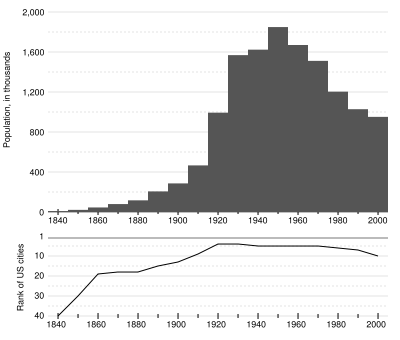 |
|
Detroit's population increased more than sixfold during the first half of the 20th century, fed largely by an influx of Eastern European and Southern migrants — both white and black — who came to work in the burgeoning automobile industry. As of the 2000 census 2, there were 951,270 people, 336,428 households, and 218,341 families residing in the city. The population density was 6,855.1 people per square mile (2,646.7/km²). There were 375,096 housing units at an average density of 2,703.0 people per square mile (1,043.6/km²). As of 2005, Detroit's population has dwindled to 886,675, representing a 6.8% loss from the 2000 Census population.
| Historical populations | ||
|---|---|---|
| Census | Pop. | %± |
|
|
||
| 1820 | 1,422 |
|
| 1830 | 2,222 | 56.0% |
| 1840 | 9,102 | 309.6% |
| 1850 | 21,019 | 130.9% |
| 1860 | 45,619 | 117.0% |
| 1870 | 79,577 | 74.4% |
| 1880 | 116,340 | 46.2% |
| 1890 | 205,876 | 80.0% |
| 1900 | 285,704 | 38.8% |
| 1910 | 465,766 | 63.0% |
| 1920 | 993,678 | 113.3% |
| 1930 | 1,568,662 | 36.7% |
| 1940 | 1,623,452 | 3.5% |
| 1950 | 1,849,568 | 13.9% |
| 1960 | 1,670,144 | -9.7% |
| 1970 | 1,514,063 | -9.3% |
| 1980 | 1,203,368 | -20.5% |
| 1990 | 1,027,974 | -14.6% |
| 2000 | 951,270 | -7.5% |
The Detroit suburbs in Oakland County and Macomb County are primarily white. Oakland County is among the most affluent counties in the nation. The suburbs of Grosse Pointe and Bloomfield Hills are filled with grandiose mansions. As of 2001, the city of Detroit was 81.55% Black ( African American). Metro Detroit has a higher percentage of blacks than any other northern U.S. metropolitan area — roughly one quarter of the area population. More than one million African-Americans live in the metropolitan area, with about 80% living within the Detroit city limits. With the suburban outflux, Metro Detroit is among the nation's most racially segregated regions. Within the city limits there are 81.55% African American, 12.26% of residents are White & Middle Eastern 0.33% Native American, 0.97% Asian 0.03% Pacific Islander, 2.54% from other races, and 2.32% from two or more races. 4.96% of the population was Hispanic or Latino of any race. The city's foreign-born population stood at 4.8%, one of the lowest percentages of the 50 largest cities in the country.
Metro Detroit's ethnic communities are diverse and include descendants of the French founders, as well as Germans, Poles, Irish, Italians, Scots, Armenians and Greeks who settled during the city's early 20th century industrial boom. Metro Detroit has the largest concentration of Belgians outside of Belgium. In Detroit and the Metro area, there is a large Chaldean population and the country's largest concentration of Arab Americans resides in Dearborn. Mexicantown, on the southwest side of the city of Detroit, is the historical centre of a small Chicano community.
There were 336,428 households out of which 33.9% have children under the age of 18 living with them, 26.7% were married couples living together, 31.6% had a female householder with no husband present, and 35.1% were non-families. Some 72% of all Detroit children are born to single mothers. 29.7% of all households were made up of individuals and 9.2% had someone living alone who is 65 years of age or older. The average household size was 2.77 and the average family size was 3.45.
There is a wide age distribution in the city, with 31.1% under the age of 18, 9.7% from 18 to 24, 29.5% from 25 to 44, 19.3% from 45 to 64, and 10.4% who are 65 years of age or older. The median age was 31 years. For every 100 females there were 89.1 males. For every 100 females age 18 and over, there were 83.5 males.
The median household income in the city was $29,526, and the median income for a family was $33,853. Males had a median income of $33,381 versus $26,749 for females. The per capita income for the city was $14,717. 26.1% of the population and 21.7% of families were below the poverty line. Out of the total population, 34.5% of those under the age of 18 and 18.6% of those 65 and older were living below the poverty line.
The National Institute for Literacy declared in 1998 that 47% of Detroiters were " functionally illiterate."
Detroit was ranked the most Liberal city in America by the Bay Area Centre for Voting Research.
Law and government
The city government is run by a mayor and nine-member city council and clerk elected on an at-large nonpartisan ballot. Since voters approved the city's charter in 1974, Detroit has had a " strong mayoral" system, with the mayor approving departmental appointments. The council approves budgets but the mayor is not obligated to adhere to any earmarking. City ordinances and substantially large contracts must be approved by the council. The city clerk supervises elections and is formally charged with the maintenance of municipal records. Municipal elections for mayor, city council and city clerk are held at four-year intervals, in the year after presidential elections (so that there are Detroit elections scheduled in 1993, 1997, 2001, 2005, 2009, etc.).
Politically, the city consistently supports the Democratic Party in local and national elections. Suburb baiting is another common feature in Detroit politics. In his 1974 inaugural address, former Mayor Coleman Young told the city's criminals to "hit Eight Mile Road" (the most prominent dividing line between Detroit and northern suburbs). When Mayor Kwame Kilpatrick found himself behind in the polls in the 2005 election, his campaign tried to draw attention to the support his opponent, Freman Hendrix, received in the suburbs. During one debate, Kilpatrick spoke of higher illegal drug use in the suburbs compared to Detroit. Many opponents have criticized Kilpatrick on the basis that many of his policies facilitate the gentrification taking place in the city.
With a decreasing population and decline in the automotive industry, the city's finances have been adversely affected. Detroit has cut its workforce and closed operations, including recreational facilities, to avoid state-ordered receivership. In addition, Detroit has demanded pay cuts and other dramatic "give backs" from the municipal unions that represent city employees. In the 2000s, Detroit has fought off legislative efforts to turn control of the city-owned Water and Sewer system to the suburbs.
Detroit's courts are all state-administered and elections are nonpartisan. The Probate Court for Wayne County are located in the Coleman A. Young Municipal Centre in downtown Detroit. The Circuit Court is located across Gratiot Ave. in the Frank Murphy Hall of Justice, also in downtown Detroit. The city is also home to the 36th District Court, as well as the 1st District of the Michigan Court of Appeals' and the United States District Court for the Eastern District of Michigan.
Detroit has several sister cities, including Chongqing (People's Republic of China), Dubai (United Arab Emirates), Kitwe (Zambia), Minsk (Belarus), Nassau, Bahamas, Toyota (Japan), and Turin (Italy).
Crime
| 2004 Crime statistics (per 100,000) |
||
|
|
||
| Crime | USA | Detroit |
|---|---|---|
| Rape | 32 | 81 |
| Robbery | 137 | 611 |
| Assault | 291 | 1,049 |
| Burglary | 730 | 1,368 |
| Larceny | 2,366 | 2,314 |
| Auto Theft | 421 | 2,755 |
According to a 2005 study, crime in downtown Detroit is much lower than national, state and metro averages. The analysis of crime in downtown Detroit by the Michigan Metropolitan Information Centre at Wayne State University found crime rates in the central city lower than rates for the entire nation, state and other large Michigan metro areas - and improving. Detroit includes a number of prosperous neighborhoods in which crime is less prevalent than in impoverished areas.
The city's crime-ridden sections have brought it notoriety. Detroit's crime figures are often among the highest in the U.S. The city is currently listed as the most dangerous city with a population over 500,000 by the Morgan Quitno's statistics, but comes after St. Louis, Missouri overall. Detroit is consistently in the top five for homicide rates. Murders peaked at 714 in 1974 (garnering Detroit the nickname "Murder City", a play on "Motor City") though the highest murder rate was recorded in 1991, when there were 615 homicides and the city's population was just over a million, which factors into a murder rate of roughly 60 per 100,000. In 2003, there were 361 homicides, the lowest count in recent years.
Many of these problems are blamed on the widespread white flight (which has contributed greatly to urban decay), poverty, de facto segregation of the region, and unemployment. Some credit years of divisive, racially polarized government under Coleman Young with accelerating this flight; during the administration of Dennis Archer, who succeeded Young, Detroit saw middle-class residents moving into the city, and a large growth in residential and commercial development.
Abandoned and burned out shells of buildings are a frequent sight, with some 16,037 empty houses recorded in 1999. The city lacks funding to demolish the properties and the homes are often used for the production, sale, and use of illicit drugs, with drug gangs such as Young Boys Inc..
The city has faced hundreds of arsons, often in the city's many abandoned homes, each year on Devil's Night, the evening before Halloween. The Angel's Night campaign, launched in the late 1990s, draws many volunteers to patrol the streets during Halloween week. The effort has reduced arson: while there were 810 fires set in 1984, this was reduced to 142 in 1996.
Brutality and the failure to ensure the rights of suspects has caused problems within the Detroit Police Department. In 2004, following scandals and multiple adverse legal decisions, a court-ordered reorganization of the Detroit Police Department was implemented under the supervision of the Federal Bureau of Investigation.
From 2005 to 2006, the Detroit Police Department has more recently undergone large scale cuts and reorganization, cutting the number of precincts from 12 to 6 "districts." While the stated purpose of this reorganization was to improve services, it has resulted in widespread dissatisfaction within the Detroit Police Department, where members cite such problems as overcrowding, overwork, greatly increased response times, and constant change in the administrative structure of the department as senior officers are moved, promoted, and replaced.
Education
The city is served by the Detroit Public Schools (DPS) district, various charters and privates schools, and parochial Roman Catholic schools run by the Archdiocese of Detroit. In the early 1970s, the federal courts ordered busing to desegregate the system, which helped to accelerate the white flight that had been ongoing in the city. As of 2004, Detroit schools were 91% African-American.
In the mid-to-late 1990s, the Michigan Legislature removed the locally elected board of education amid allegations of mismanagement and replaced it with a reform board appointed by the mayor and governor. The elected board of education returned following a city referendum in 2005. The first election of the new eleven member board of education occurred on November 8, 2005. Due to rapidly declining enrollment, Detroit Public Schools has projected the closure of 95 schools by 2009. Detroit Public Schools has closed 29 schools, and the state mandated deficit reduction plan calls for the closure of a total of 110 schools.
The Detroit area has several universities and colleges. Wayne State University is a national research university with medical and law schools in the Midtown area. Other institutes of higher education include the University of Detroit Mercy with its schools of Law and Dentistry, the College for Creative Studies, Lewis College of Business, Marygrove College, and Wayne County Community College, Lawrence Technological University in Southfield, Henry Ford Community College in Dearborn, Oakland University and Rochester College in Rochester, and Ave Maria College in Ypsilanti, and Ave Maria School of Law in Ann Arbor. The Detroit College of Law, now affiliated with Michigan State University, was founded in the city in 1891 and remained there until 1997, when it relocated to East Lansing. The University of Michigan in Ann Arbor has campuses in Flint and Dearborn.
Infrastructure
Medicine
The city of Detroit has three major medical systems: the Detroit Medical Centre (DMC), Henry Ford Health System, and the St. John Hospitals. The DMC, a regional Level I trauma centre, consists of Detroit Receiving Hospital and University Health Centre, Children's Hospital of Michigan, Harper University Hospital, Hutzel Women's Hospital, Rehabilitation Institute of Michigan, Sinai-Grace Hospital, and the Karmanos Cancer Institute. The DMC has more than 2,000 licensed beds and 3,000 affiliated physicians. The centre is staffed by physicians from the Wayne State University School of Medicine, the largest single-campus medical school in the United States. The Metro Detroit area has many other medical facilities.
Transportation
Because of its proximity to Canada and its industrial facilities, major highways, rail connections and international airport, Detroit has been an important transportation hub. There are three international border crossings at the Ambassador Bridge, Detroit-Windsor Tunnel and Michigan Central Railway Tunnel, linking Detroit to Windsor, Ontario. Some 35% of U.S. trade with Canada passes through Detroit. The Ambassador Bridge is the nation's busiest border crossing, carrying 25% of the total trade between the U.S. and Canada.
Detroit is also connected via Interstate 94 to Kings Highway 402 and to major Southern Ontario cities such as London, Ontario and the Greater Toronto Area along Highway 401. Upon construction and completion of a third border crossing, Detroit and the surrounding area would have a third direct link to the 400-Series freeway network, and have a direct connection to Kings Highway 401, eliminating (or greatly diminishing) the traffic jams that plague the Ambassador Bridge, and the Detroit-Windsor Tunnel.
Detroit is the crossroads for three Interstate Highways: I-94 ( Edsel Ford Freeway), I-96 ( Jeffries Freeway) and I-75 (Fisher and Chrysler Freeways). I-696 ( Walter Reuther Freeway) serves the northern suburbs, while I-275 serves the western suburbs and I-375 is a short extension of the Chrysler Freeway. Other major routes are the John C. Lodge Freeway ( M-10), the Southfield Freeway (M-39) and the Davison Freeway (M-8). Detroit and surrounding close suburbs are also served by a square grid network of major arterial roads.
Coleman A. Young International Airport (DET), previously called Detroit City Airport, is on Detroit's northeast side. Although Southwest Airlines once flew from the airport, there is currently only charter service. Detroit Metropolitan Wayne County Airport (DTW), the area's principal airport, is located in nearby Romulus and is a hub for Northwest Airlines and Spirit Airlines. Toledo Express Airport in Toledo, Ohio, is a secondary commercial passenger airport. Willow Run Airport, in far-western Wayne County near Ypsilanti is a general aviation and cargo airport.
Mass transit in the city functions in two separate spheres of influence. Bus services are provided by the Detroit Department of Transportation (DDOT), which terminates at the outer edges of the suburbs. Services in the suburbs are provided by the Suburban Mobility Authority for Regional Transportation (SMART). Combining the systems has been problematic and tainted by the racial politics that has affected all aspects of city–suburban relationships. Cross border service between the downtown areas of Windsor and Detroit is provided by Transit Windsor via the Tunnel Bus.
An automated guideway transit system known as the People Mover provides a 2.9 mile (4.6 km) loop in the downtown area and usually operates daily. Amtrak provides service to Detroit, operating its Wolverine service between Chicago, Illinois, and Pontiac. The current passenger facility north of downtown replaced the presently unused Michigan Central Station, which was opened in 1913 and vacated in 1988.
Currently, a study is underway to investigate the feasibility of a Detroit-Ann Arbor commuter line, which would service the nearly 100,000 daily commuters between the two regional hubs. The proposed system would be funded by a $100 million federal grant that is secured based on the results of the study. Recently, the city also announced it would begin studies for mass transit on a greater scale for the entire metropolitian area.
